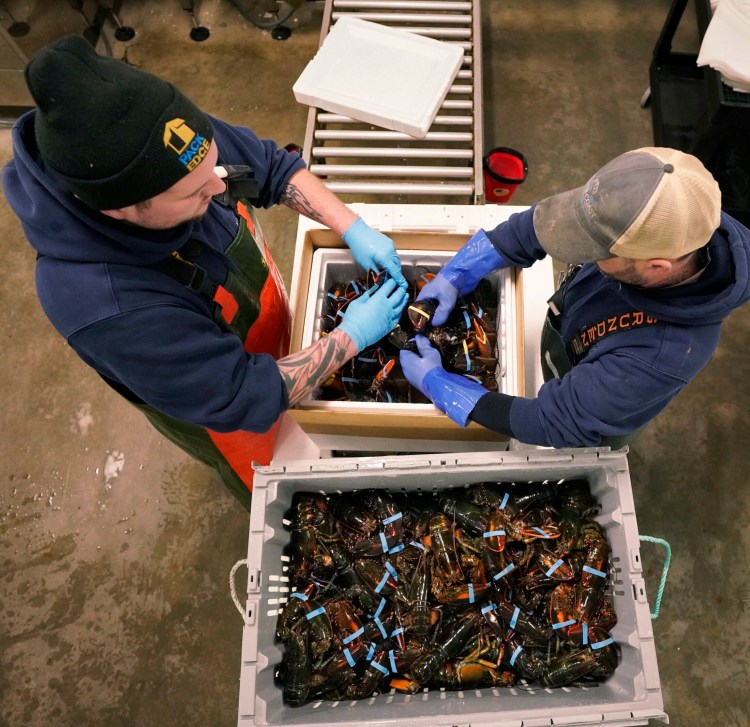A federal agency is seeking a 60 percent to 80 percent reduction in the number of right whales killed or seriously injured by fishing line entanglement – a mandate that could have serious implications for the future of Maine’s $485 million lobster industry.
The National Marine Fisheries Service estimates that fishing rope entanglement kills or seriously injures five to nine right whales a year. Federal scientists believe that even a single death a year would prove too much for the endangered species to make a recovery.
If those deaths are split evenly between the U.S. and Canada, a fisheries service assumption that Maine fishermen and regulators question, then Maine and Massachusetts lobstermen would have to find a way to cut their share of the whale entanglement deaths by 6o percent to 80 percent to achieve that goal.
“We know this target is daunting, but it is necessary to ensure the recovery of the North Atlantic right whale population,” said Colleen Coogan, coordinator of the agency-led team created to protect the right whale, in a letter emailed Friday to team members, including Maine fisheries regulators.
Read a fisheries service memo on proposed right whale protections
Patrick Keliher, head of the Maine Department of Marine Resources, announced the proposed target at a conference of U.S. and Canadian lobstermen in Portland Friday while defending a decision to cancel three meetings with Maine fishermen to talk about looming right whale protections.
Keliher said he made the decision because the fisheries service hadn’t shared its risk-reduction target, so he didn’t feel he had enough information to share with the Maine fishing industry. He said he would attend two whale meetings coming up later this month and reschedule the industry meetings when he knew more.
He said he was alarmed that the fisheries service had raised the possibility of using untested scientific methodologies and last-minute analyses to help make its decision on what steps should be taken to protect whales from entanglement. “I don’t want to use a clunky tool,” he said. “I want one that’s been tested.”
A few minutes later, Keliher got an email from the fisheries service that spelled out its risk reduction target. Frustrated, he stood up and delivered apparent bad news – he told an already exasperated audience that the service now wanted a 60 percent to 80 percent reduction in the size of the lobster fishery. The room erupted with anger.
Keliher later corrected himself, saying that he meant to say that the service wanted the fishery to find a way to reduce right whale entanglement deaths and serious injuries by 60 percent to 80 percent. That quieted the crowd a bit, but Keliher noted the corrected statement was still bad news for the industry.
“We got our target, but it’s higher than we expected,” Keliher said. “I was thinking 40 percent.”
The right whale population has fallen to just 411 individuals, including about 100 breeding females. The agency attributes 2.6 to 4.3 right whale deaths a year to entanglements in U.S. fishing gear, based on an assumption that responsibility for right whales entanglement is shared equally by the U.S. and Canada.

Charlene Maillet and Gilles Maillet from Shediac, New Brunswick, left, chat with Geoff Irvine and Julie Toman, from Halifax, Nova Scotia, during a seafood reception at the Canadian-U.S. Lobsterman’s Town Meeting in Portland on Friday. Brianna Soukup/Staff Photographer
Keliher said it is too early to say what this kind of reduction in whale mortalities and injuries would mean for Maine fishermen, which are facing the possibility of large scale changes to how they fish, ranging from putting more traps on every vertical line and only fishing with weak surface-to-seabed rope to more drastic possibilities such as seasonal closures and trap reductions.
On April 23, a NOAA task force will discuss how to protect the endangered right whale from fishing gear. On April 29, the Atlantic States Marine Fisheries Commission will debate how to reduce the number of vertical fishing lines.
Send questions/comments to the editors.



Comments are no longer available on this story